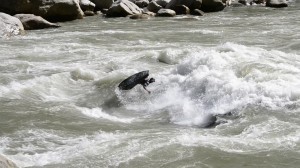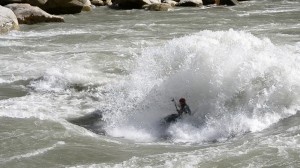Now that the video is almost complete, I finally have some time to write about my trip to the Salween River in Yunnan, China.
The expedition was inspired by the fact that the river offers some of the best big wave action in the world in an absolutely gorgeous and remote region of Western China. Its high mountain peaks and stunning valley below would astonish any traveler to this region. In addition to its beautiful scenery, the population of the Nujiang canyon is composed of over 90% ethnic minority persons (Lisu, Nu, Tibetan, and Dulong). This is exceptionally rare in China considering the entire country has approximately 1.2 billion people, of which over 1 billion of them are considered “Han Chinese”.

My travels weren’t easy; language barriers, protecting a carbon-fibre boat, and kayaking alone presented themselves as major obstacles. At first, I did not know a word of Chinese. The only help I had was a small phrase-book and a friend halfway across the country that I could call if I was truly in a bind. It took several weeks before I had any real say in terms of the food I ate, since no one at any of the “restaurants” could understand me. This meant spicy noodles for breakfast, lunch, and dinner. The language barrier also made it scary at points, due to the fact my kayak is made from carbon-fibre. It is fairly fragile and therefore should not be mishandled. Most of the people in Yunnan have probably never seen this material before, let alone have an appreciation for what it means to handle such a brittle & expensive object. Not to mention, it was pretty much the sole reason I made the journey to this far and distant region. If it broke I would of course be forced to forget any dreams of accomplishing all that I had set out to. My reason for being there was mostly to kayak. I had long envisioned surfing big waves and running HUGE rapids. It took me awhile to actualize this dream. Traveling and kayaking alone meant that I must scout each section slowly & carefully. This was a long, strenuous process but ultimately rewarding. At first, I had no idea where anything was along the river. Besides speaking to a few other kayakers who had been to the Salween before, there wasn’t much information available to help plan my trip. I set off to different sections each day in hopes of finding new rapids and waves. The river changed water levels quite a lot during my stay there, hence I would paddle the same section twice or even three times before finding certain features such as the main wave known as ”firestarter”.
Besides not knowing the river very well prior to my arrival, there were many other logistical matters to sort out. I was very unsure of how best to transport myslef and my boat up and down the valley each day. Fortunately, my hotel was directly across the street from the bus station, which happened to have a trunk compartment perfectly sized for a small playboat, such as my imitation 2010 All-Star. During my two and a half week stay in Gongshan, many of these problems sorted them selves out, while others simply weren’t important enough to care about. Overall, it was a relatively cheap way of achieving all the big water action I hoped for, while at the same time providing many oppportunities to experience Chinese culture on my own.

Having done this mission alone left me with a special sense of connectedness to the river and its surrounding environs. The fact that it might be damed is one of the reasons I felt such a great sense of urgency in doing the trip before it was too late. While I cannot claim to be an expert on the matter, I do know it will be a shame to lose such a wonderful and magestic place to the construction of a hydro-project. For sure, China requires clean energy to fuel its economic growth; but at what expense? This region in particular is host to many unique and/or endangered species, some not observed anywhere else in the world. Daming this site would mean losing this rich biodiversity both in plant life and its amazing fauna. As mentioned previously, it would also disrupt the lives for many ethnic minority cultures… destroying centuries of culture & tradition. If completed, the 13 dams in all would cost more (roughly 90 billion yuan = $15 billion USD) and generate more electricity than that of the Yangtze Three Gorges Dam project, making it the largest of its kind.
I’m happy to be able to share my experiences from this trip and with others; an opportunity not to be taken for granted after travling in China for so long and witnessing the kind of government censorship that takes place. This mission was a first of its kind, in that no other person has kayaked the Salween (Nujiang in Chinese) alone.
Here is a sneak peak:
The full edit is now complete and will be uploaded soon…
Cheers & Merry Christmass / Happy Hollidays,
Ian
Categories:
